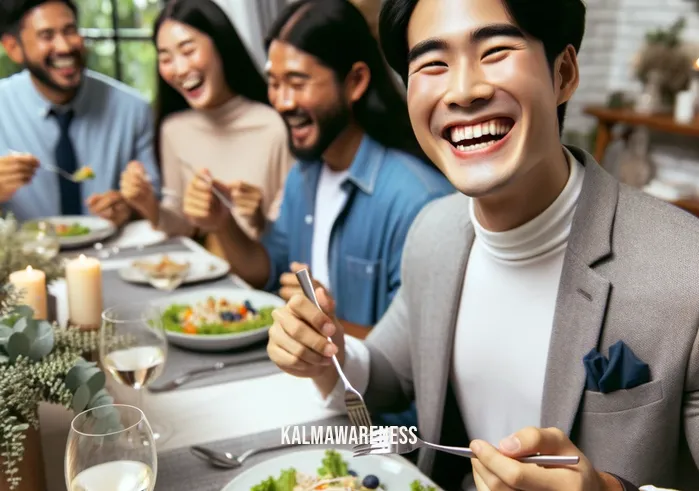Mastering “Mindfully Your Cravings”: The Journey Begins
Every one of us, at some point, has been swayed by our cravings. Whether it’s that sugary snack after dinner or the urge to skip a workout, the pull is real and often challenging to resist. But what if I told you there’s a way to understand, manage, and even leverage these cravings for a healthier, more balanced life? The solution lies in the practice of mindfulness. In this comprehensive guide, we will delve into how you can “mindfully” handle your cravings, drawing from ancient wisdom, scientific research, and practical methods.
Understanding Our Cravings: More than Just a Desire
Cravings are not just random desires. They are rooted deeply in our habitual thinking patterns and can often dominate our decision-making process. An exploration of the habitual thinking definition reveals that our repeated behaviors can cement certain neural pathways, making it challenging to break free. By understanding the mechanics behind our thoughts, we take the first step towards addressing our cravings in a holistic manner.
Mindfulness: The Antidote to Impulsive Desires
At its core, mindfulness is about being present—truly present—in every moment. The timeless wisdom behind this can be traced back to various cultures and traditions. One of the notable methods that emphasize mindfulness is the ancient African meditation techniques. These techniques, while rooted in a particular culture, offer universal insights into achieving mental tranquility and clarity.
But how does mindfulness help with cravings? It’s simple. By being present, you become acutely aware of your desires and the triggers that lead to them. This heightened awareness allows you to respond rather than react, leading to more informed choices. A brilliant resource that encapsulates this is life is available only in the present moment, reminding us of the power of now.
From Stillness to Motion: Mindful Practices
Mindfulness isn’t limited to still meditation. There are numerous ways to practice it, even in motion. One such method is through mindful martial arts. Martial arts, by their nature, require utmost concentration and self-awareness. By channeling these principles for everyday cravings, we can achieve a state of balance.
Similarly, for those who find solace in nature, mindful hiking offers a beautiful blend of physical activity and meditative contemplation. It’s about immersing oneself in the natural environment and being completely present, making every step count.
Building a Mindful Lifestyle: Beyond Momentary Practices
While specific practices help in cultivating mindfulness, it’s equally crucial to build an overall mindful lifestyle. This includes reading and educating oneself. For the younger readers, there’s an excellent collection of mindfulness books for teens that can serve as a starting point. For adults, exploring mindful muscle and integrating mindfulness into daily routines, like yoga through rouse yoga, can be tremendously beneficial.
Looking Ahead
While this segment provides an overview of mindfully addressing cravings, there’s so much more to discover. From understanding the science behind mindfulness to diving deep into various mindful practices, our journey has only just begun.
In the next segment, we will delve deeper into the tangible benefits of mindfulness and how it translates into real-world scenarios, helping us tackle cravings and lead a balanced life. Stay with us, for the journey promises to be transformative.

Mindful Mechanisms: Tackling Cravings Through Awareness
In our daily lives, various stimuli continually tug at our attention. A tempting slice of cake, a thrilling episode of a favorite series, or even the beckoning call of a cozy bed when we should be exercising. All these are manifestations of our cravings, which can sidetrack our goals if not managed mindfully. To truly thrive and lead a balanced life, understanding the mechanisms behind these urges becomes paramount. In this chapter, we’ll delve deeper into the strategies and concepts that can help you navigate cravings by being present and attentive.
The Science Behind Cravings
Cravings, at their core, are intense desires triggered by various factors. These can be physiological, like hunger or thirst, or psychological, stemming from emotions or habits. But being mindful can act as a buffer, giving us the space to choose our response. An insightful dive into meditation pleine conscience (or mindful meditation) showcases the interplay of our brain’s different regions when confronted with a craving, illustrating how mindfulness can temper impulsive reactions.
Strategies to Handle Cravings: A Mindful List
- Micro-Meditation: Instead of long meditation sessions, micromeditating involves short bursts of mindfulness throughout the day, especially during high-craving moments.
- Breathing Techniques: An integral part of mindfulness, specific breathing exercises can help in grounding us. The Breathing and Meditation techniques offer a gamut of methods to anchor oneself during turbulent cravings.
- Mindful Movement: Activities like mindful martial arts or mindful hiking channelize the energy from cravings towards productive physical exertion.
- Stay Informed: Regularly updating oneself about the latest research or techniques can be immensely beneficial. Engaging reads, such as those about mindful miracles, can be a treasure trove of actionable insights.
- Seek Expert Guidance: Consider consulting a meditation consultant who can offer personalized strategies and techniques.
Mindful Management of Cravings: A Snapshot
| Trigger | Mindful Response | Beneficial Outcome |
|---|---|---|
| Emotional distress | Practicing micromeditating | Reduced anxiety, improved emotional balance |
| Exposure to tempting food | Deep Breathing and Meditation | Increased resistance to indulgence |
| Social Pressure | Engage in mindful martial arts | Enhanced self-awareness, reduced susceptibility |
| Habitual Behavior | Dive into mindful miracle stories | Motivation and inspiration to change habits |
| Boredom | Consult a meditation consultant | Personalized strategies to redirect energy |
It’s essential to understand that mindful strategies aren’t about suppressing or denying cravings. Instead, they offer a middle path—recognizing the craving, understanding its source, and then making an informed decision about how to respond.
Our journey into mindfulness and cravings doesn’t stop here. While we’ve delved into mechanisms and strategies in this chapter, in the next chapter, we’ll explore real-life testimonials and stories. These narratives will provide a more personal touch, showcasing how others have successfully navigated their cravings using mindfulness.
Eager to learn from others’ experiences? Continue reading…

Stories of Resilience: Conquering Cravings Mindfully
The concept of confronting cravings mindfully is not just a theory—it’s a practice that many have integrated into their lives with profound results. Throughout history, individuals have faced and harnessed their desires through mindfulness, turning them into sources of strength and transformation. This chapter seeks to shine a light on some of these inspiring tales, lending both hope and practical insights to those on a similar journey.
“In the Midst of Chaos, There is Also Opportunity” – Sun Tzu
Consider the tale of Mia, a college student, who always found solace in Penn’s mindfulness class. Amidst the pressures of academics and social life, Mia often felt the gravitational pull of stress-eating. Discovering the mindfulness class became her turning point. Not only did she learn techniques to be present in the moment, but she also found a community that inspired her daily. Through consistent practice, Mia transformed her relationship with food, seeing it not as a crutch, but as nourishment.
“To Conquer Oneself is a Greater Task Than Conquering Others” – Buddha
James, an executive, was always on the go. His fast-paced life, full of meetings and travel, left him little time for reflection. This lack of pause often led him to mindlessly indulge in unhealthy habits. Everything changed when he chanced upon mindfulness books for teens that he intended to buy for his daughter. Diving into these resources made him realize the power of self-control and mindfulness. Seeking guidance, James connected with a meditation consultant, who tailored practices to fit his hectic schedule. Today, he’s not only more present in his professional life but also cherishes every moment with his family.
“The Only Way to Make Sense Out of Change is to Plunge into it, Move with it, and Join the Dance” – Alan Watts
Sophia, an artist, always felt a unique connection to her surroundings. Yet, she battled the persistent craving to seek validation through social media. This constant digital consumption stifled her creativity. A chance encounter with the concept of meditation in motion introduced her to a novel way of grounding herself. Sophia began integrating mindfulness into her art, transforming her cravings for external validation into a deeper connection with her inner self. Her artwork flourished, resonating more authentically with her audience.
From Stories to Real-Life Practice
The above narratives are not just tales—they’re reminders that no matter where we come from or what we do, the essence of our challenges remains similar. The thread of mindfulness, woven through each of these stories, underscores the power of presence in transforming cravings.
- Personalized Approach: Just as James sought a meditation consultant, finding a tailor-made approach is crucial.
- Community Support: Like Mia, surrounding oneself with a supportive community, perhaps through mindful classes, can be immensely uplifting.
- Dive into Resources: Reading and constantly educating oneself, perhaps starting with mindfulness books for teens, can provide fresh perspectives.
Gearing Up for the Journey Ahead
While stories of resilience inspire and motivate, the real journey lies ahead. The path of mindfulness, with all its challenges and triumphs, awaits each one of us. In the next chapter, we will delve into the practicalities—tools, techniques, and actionable steps that you can integrate into your life, starting today.
Curious about the next steps on this transformative path? Continue reading…

Mindful Mastery: Decoding the Art of Addressing Cravings
As we’ve embarked on this journey, we’ve delved into the nuances of cravings, understood their underpinnings, and been inspired by real-life stories. Now, it’s time to break down the art of handling these cravings mindfully into tangible, bite-sized insights. This chapter aims to provide you with a clear roadmap, using structured formats like bullet points and lists, to help integrate mindfulness into your daily encounters with cravings.
Components of a Craving
- Trigger: An external or internal stimulus leading to the craving.
- Examples include stressful situations, seeing tempting advertisements, or even certain times of the day.
- Emotion: The feeling accompanying the craving, often intense.
- This can range from anxiety, sadness, or boredom to joy and excitement.
- Response: The immediate reaction to the craving, often impulsive.
- This is where mindfulness can play a pivotal role, helping shift from impulsive reactions to thoughtful responses.
Steps to Mindfully Address Cravings
- Recognition:
- Acknowledge the craving without judgment.
- Utilize tools like mindful en español to understand the universality of such experiences.
- Analysis:
- Dive deep into the root of the craving. Is it emotional? Habitual? Triggered by external factors?
- Refer to concepts such as habitual thinking definition to get a clearer picture.
- Breathing and Grounding:
- Engage in deep breathing exercises to center yourself.
- Explore methods such as meditation for menopause which, though specific in title, offers universal grounding techniques.
- Mindful Decision Making:
- With a clearer mind, decide how to address the craving.
- Choices might include indulging mindfully, redirecting attention, or engaging in a mindful miracle activity to channel the energy.
- Reflection:
- Post the encounter, reflect on the experience.
- What did you learn? How can you better handle such situations in the future?
Tools to Assist in the Journey
- Guided Meditations: Audio or visual aids, often available on platforms like mindful muscle, that guide you through a mindfulness session.
- Mindful Journals: A space to jot down your experiences, reflections, and learnings.
- Mindfulness Apps: Digital platforms offering a range of tools, from timers to guided sessions.
- Communities and Classes: Join groups, such as those at Penn’s mindfulness class, to share experiences and learn collectively.
Overcoming Common Challenges
- Consistency: Establish a routine. Whether it’s five minutes a day or an hour a week, consistency is key.
- Overwhelm: Remember, mindfulness is a journey. Start small, perhaps with micromeditating, and gradually expand your practices.
- Distractions: In today’s digital age, distractions are abundant. Dedicate a specific space for your mindfulness practices, free of digital devices.
- Judgment: One of the cornerstones of mindfulness is non-judgment. Every experience, whether deemed ‘good’ or ‘bad,’ offers learning.
As we conclude this chapter, we hope you feel equipped with the tools and insights to navigate your cravings mindfully. However, our journey doesn’t end here. In the final chapter, we will consolidate our learnings, offering a holistic perspective and steps for continuous growth.
Eager to see how all the pieces of the puzzle fit together? Continue reading…

Mindful Moments: Reflecting on our Journey of Conquering Cravings
As we reach the final bend in our exploration of addressing cravings mindfully, it’s time to pause, reflect, and assimilate all that we’ve uncovered. From understanding the very nature of cravings to diving deep into the transformative power of mindfulness, our journey has been enlightening, inspiring, and empowering.
A Glimpse Back
Understanding Cravings: At the heart of every craving lies a complex interplay of emotions, triggers, and responses. By deciphering this, we unlocked the first door to mindful management.
Mindfulness in Action: Through tales of resilience and hope, like those from Penn’s mindfulness class, we saw how theoretical concepts translate into real-life transformations.
Practical Roadmap: Breaking down the art of addressing cravings into tangible steps offered a blueprint for those ready to embark on their personal journey.
The Power of Presence
Embracing mindfulness isn’t merely about addressing cravings or enhancing self-control. It’s a holistic approach to life. By being present—truly present—in each moment, we unlock a treasure trove of experiences, emotions, and insights. The ancient wisdom of ancient African meditation techniques and the modern-day interpretations in mindful en español all underscore this timeless truth.
Taking the Next Step
With this newfound knowledge, where do you go from here?
- Revisit and Reflect: Every once in a while, revisit the chapters, especially the tools and techniques section, to keep your practice vibrant.
- Community Building: Join mindfulness groups or classes like those at gratitude yoga princeton to keep the flame of inspiration alive.
- Stay Updated: Our platform continually curates and shares new insights, stories, and techniques. Keep exploring and enriching your mindfulness journey.
A Heartfelt Thank You
To every reader who has accompanied us on this enlightening journey, we express our deepest gratitude. Your curiosity, engagement, and dedication to personal growth have made this exploration all the more meaningful. As we wrap up this chapter, remember that every end is a new beginning. Our platform promises more insightful, impactful, and transformative content in the upcoming editions.
Ready for more enlightening journeys? Eager to explore the vast realms of mindfulness, well-being, and holistic growth? We invite you to delve deeper into our magazine, uncovering treasures that resonate, inspire, and empower. Explore more…





